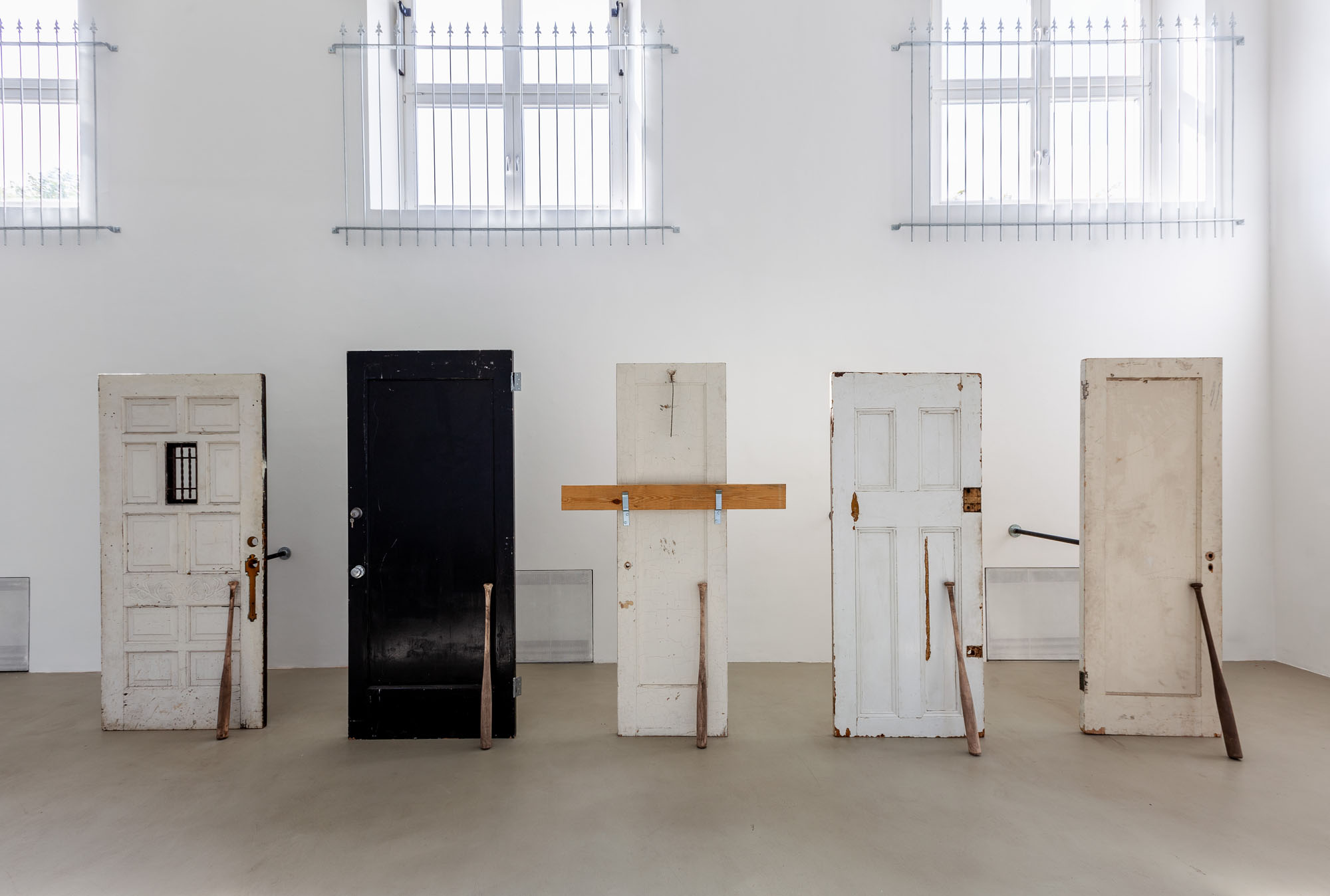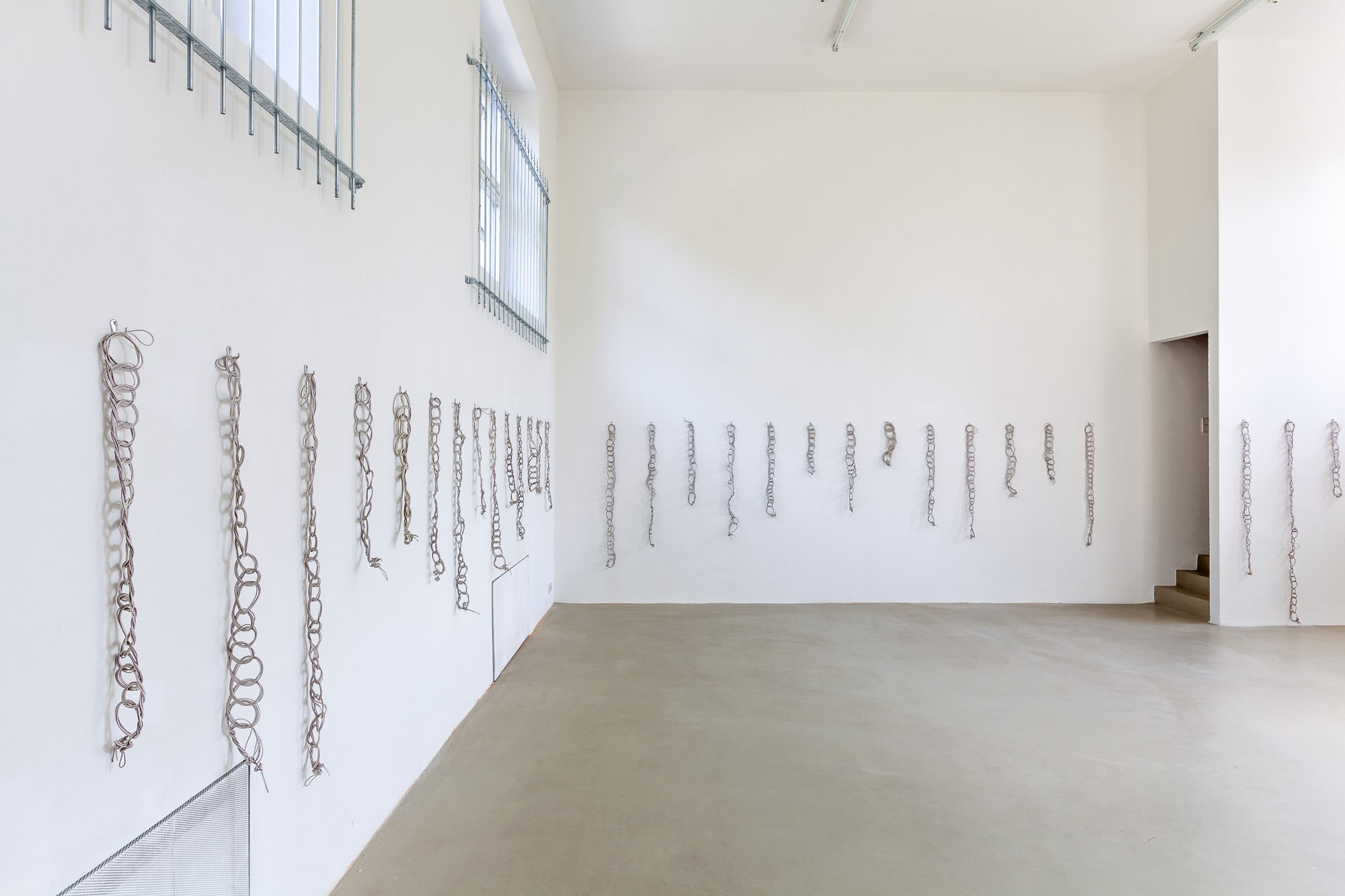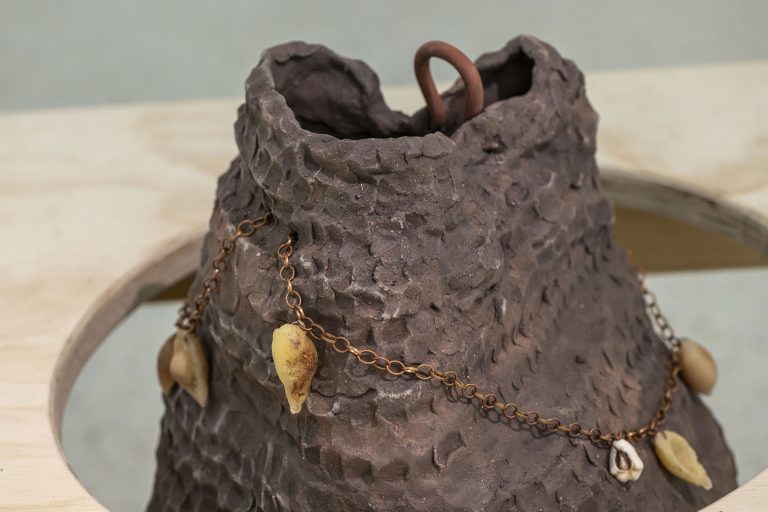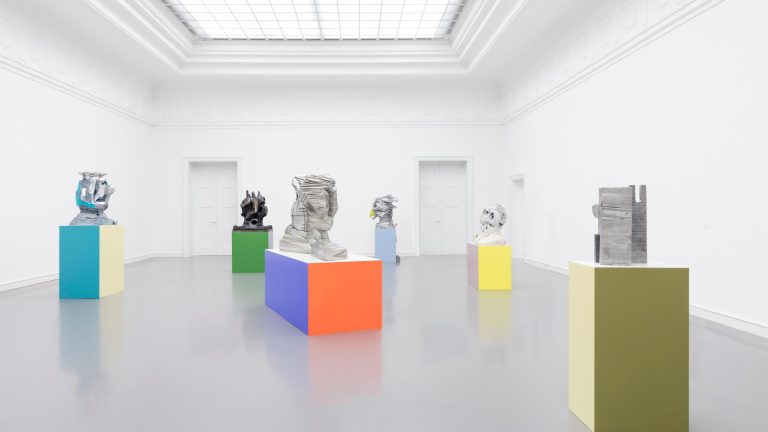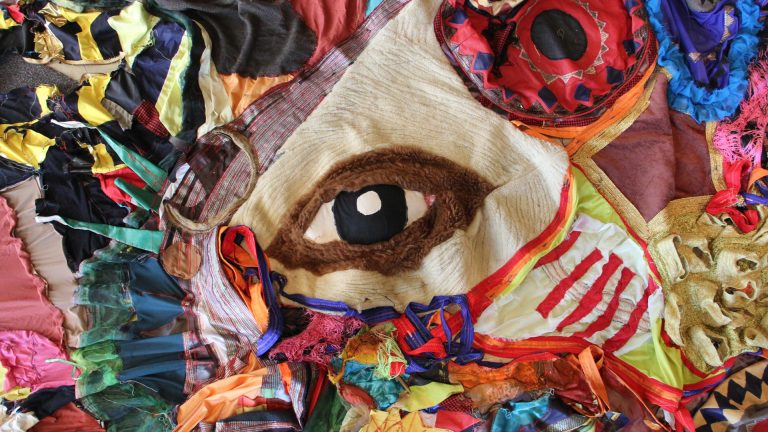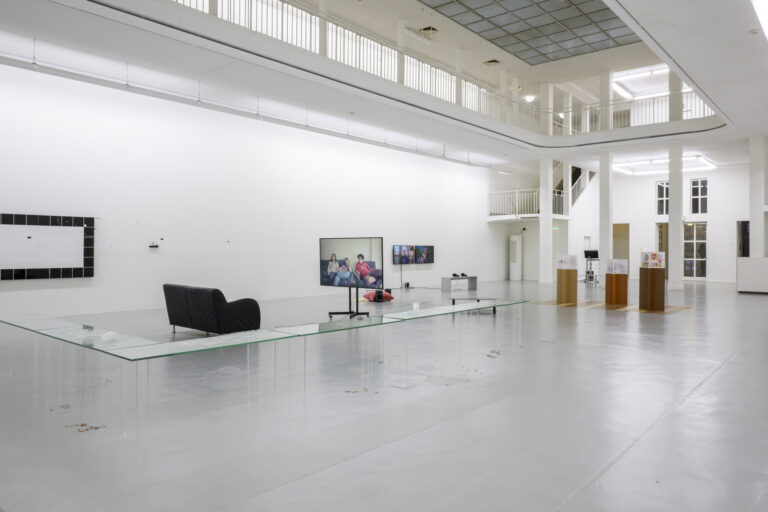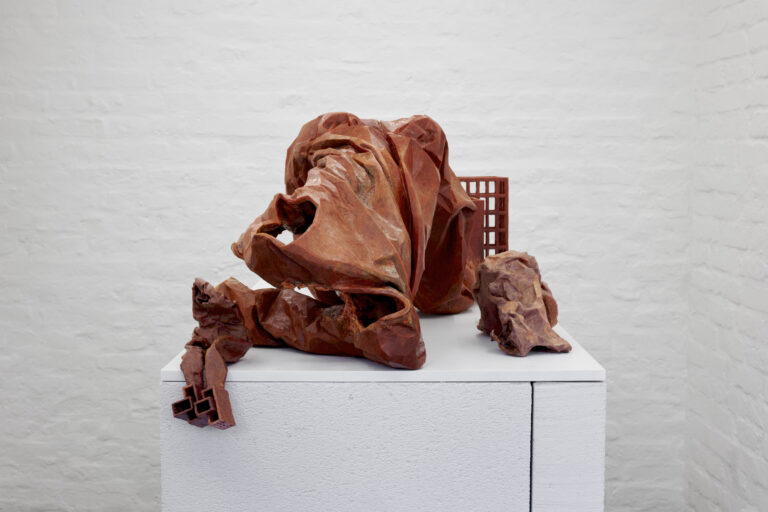Artist: Diamond Stingily
Exhibition title: Wall Sits
Venue: Kunstverein München, Munich, Germany
Date: September 21 – November 17, 2019
Photography: All images copyright and courtesy of the artist and © Kunstverein München
Diamond Stingily (born 1990 in Chicago) addresses the materiality and mythology of identity and social class. Using everyday found objects such as hair, doors, or chains, Stingily negotiates personal and collective memories by relating them to social and economic questions. Wall Sits, at Kunstverein München, is Stingily’s first institutional solo exhibition in Europe, and presents an overview of various groups of her work, as well as new productions that relate to the Kunstverein and its urban environment.Stingily’s artistic practice encompasses video, sculpture, and writing, and draws relations between the intimacy of one´s own biography and perceptions of history. Instead of working on representation of black communities in general, she examines childhood memories, which, fragmentarily, speak of the systemic racism and violence inscribed into US-American culture.
On the 1st floor of the Kunstverein, dark archive shelves filled with hundreds of trophies stand in rows one behind the other. In the middle but in the corner of 176th place (2019) consists of over 700 individual works that occupy the entire space. Most of the trophies are standardized cups awarded to the participants of conventional competitions; some are larger and recall official awards ceremonies. Their gilded labels, which normally attest to the respective sport and position achieved, are replaced by short text passages such as THROUGH ALL THE MADNESS THIS IS ALL YOU ARE GOING TO GET, I DID THE BEST I COULD WITH WHAT I HAD, or I DID IT FOR THE GLORY. These self-awarded trophies tell a non-linear story about obsessions with triumph, competition and failure. Entirely absent are descriptions of how winning could look or feel like. The texts revolve around exhaustion. And perhaps cautious apologies: I AM DOING THE BEST I CAN. A portrait of the fixation on competition and winning, in which the “American dream” is mirrored as an unattainable fiction, though a reference. Stingily comes from a family of athletes; two brothers play in the NFL, the US-American professional football league. She herself compares the experience as an artist with that of an athlete. Questions of resilience, endurance and risk in the face of apparent impossibility, and irrepressibly joy in overcoming obstacles are addressed. For Stingily, people in top-level sport are defined more by an attitude than a particular kind of activity. It is a state in which pain, competition and triumph override.
The repeating engravings also portray Stingily’s own upbringing in seemingly playful statements like WE DIDN´T HAVE THIS SPORT WHERE I WAS AT. This one, for example, refers to Stingily’s childhood, growing up in suburban Chicago in neighborhoods like Country Club Hills with predominantly black population. Questions of access to materials, relating to economic conditions that derive from systemic inequality are also addressed in the work Double Dutch Ropes (2019). In found, cheap materials, this series – installed in the rear space of the exhibition – imitates the skipping ropes that can normally be bought in children´s toy shops. Knotted and woven loops of telephone cords hang on the wall – materials available for free in place of toys that have to be purchased.
Through the use of found, common materials, Stingily deals with the mutual conditionality of artistic production and social class. Questions of race and gender are often reflected in contemporary artistic discourse on identity politics, but those of social class are largely absent. But for Stingily artistic form is always a means to reflect on origin and therefore class. Who has access to which materials? What can be found, appropriated, utilized?
The windows of the exhibition space are darkened by multiple layers of local newspaper. Commonly used in commercial premises in urban centers to mark transition from one owner to the next, or to indicate closure, here they portray the institutional space as an urban exterior. Their yellowing, sun-bleached condition and their dates usually provide information about property prices or crisis. Stingily reflects spaces as culturally constructed and historically mutable – just as the Kunstverein, with its first exhibition in the new program gives the impression of an ongoing reconstruction. Metal window grids, usually mounted at ground floor level, are installed in front of the high windows. They are the placing of a barrier, and anticipate imagined intruders. The work, titled Outside (2019), marks divisions between public and private, and allocates visitors a place outside.
The work titled Entryways (2019) consists of five worn-out doors, all with locks – held at a distance from the wall by metal bars. Leaning against each door is a used baseball bat – an object thought about in action. It refers to Stingily´s grandmother Estelle who always kept one by the front door. The bats are a manifestation of systemic violence in a culture in which black bodies are subject to brutality. “I think violence is a part of every day for a lot of people – to be non-violent I think is a very privileged thing. To not live in violence is a privilege.” But the doors also stage a counter-narrative to the stereotypical representation: via the grandmother’s domestic space they tell a matriarchal story of protection and safety.
The exhibition’s title, Wall Sits, refers to an endurance-training exercise in which you sit at 90 degrees to the wall with your feet on the floor and retain this position as long as possible. In Stingily’s childhood it was used as a punishment – that, painful as it was, also had a sporting function.
Diamond Stingily, Cameron Stingily 2019, photograph, courtesy the artist; Queer Thoughts, New York
Detail of Diamond Stingily, In the Middle but in the Corner of 176thplace, 2019; installation view of Wall Sits, 2019 at Kunstverein München, Munich; courtesy the artist; Queer Thoughts, New York; photography: Jonah Gebka
installation view of Wall Sits, 2019 at Kunstverein München, Munich; courtesy the artist; Queer Thoughts, New York; photography: Margaritas Platis
installation view of Wall Sits, 2019 at Kunstverein München, Munich; courtesy the artist; Queer Thoughts, New York; photography: Margaritas Platis
installation view of Wall Sits, 2019 at Kunstverein München, Munich; courtesy the artist; Queer Thoughts, New York; photography: Margaritas Platis
installation view of Wall Sits, 2019 at Kunstverein München, Munich; courtesy the artist; Queer Thoughts, New York; photography: Margaritas Platis
installation view of Wall Sits, 2019 at Kunstverein München, Munich; courtesy the artist; Queer Thoughts, New York; photography: Margaritas Platis
Detail of Diamond Stingily, In the Middle but in the Corner of 176thplace, 2019; installation view of Wall Sits, 2019 at Kunstverein München, Munich; courtesy the artist; Queer Thoughts, New York; photography: Margaritas Platis
Detail of Diamond Stingily, In the Middle but in the Corner of 176thplace, 2019; installation view of Wall Sits, 2019 at Kunstverein München, Munich; courtesy the artist; Queer Thoughts, New York; photography: Margaritas Platis
Detail of Diamond Stingily, In the Middle but in the Corner of 176thplace, 2019; installation view of Wall Sits, 2019 at Kunstverein München, Munich; courtesy the artist; Queer Thoughts, New York; photography: Margaritas Platis
installation view of Wall Sits, 2019 at Kunstverein München, Munich; courtesy the artist; Queer Thoughts, New York; photography: Margaritas Platis
Detail of Diamond Stingily, In the Middle but in the Corner of 176thplace, 2019; installation view of Wall Sits, 2019 at Kunstverein München, Munich; courtesy the artist; Queer Thoughts, New York; photography: Margaritas Platis
installation view of Wall Sits, 2019 at Kunstverein München, Munich; courtesy the artist; Queer Thoughts, New York; photography: Margaritas Platis
installation view of Wall Sits, 2019 at Kunstverein München, Munich; courtesy the artist; Queer Thoughts, New York; photography: Margaritas Platis
installation view of Wall Sits, 2019 at Kunstverein München, Munich; courtesy the artist; Queer Thoughts, New York; photography: Margaritas Platis
installation view of Wall Sits, 2019 at Kunstverein München, Munich; courtesy the artist; Queer Thoughts, New York; photography: Margaritas Platis
Detail of Diamond Stingily, Double Dutch Ropes, 2019; installation view of Wall Sits, 2019 at Kunstverein München, Munich; courtesy the artist; Queer Thoughts, New York; photography: Margaritas Platis
installation view of Wall Sits, 2019 at Kunstverein München, Munich; courtesy the artist; Queer Thoughts, New York; photography: Margaritas Platis
Detail of Diamond Stingily, Entryways, 2019; installation view of Wall Sits, 2019 at Kunstverein München, Munich; courtesy the artist; Queer Thoughts, New York; photography: Jonah Gebka
installation view of Wall Sits, 2019 at Kunstverein München, Munich; courtesy the artist; Queer Thoughts, New York; photography: Jonah Gebka
installation view of Wall Sits, 2019 at Kunstverein München, Munich; courtesy the artist; Queer Thoughts, New York; photography: Jonah Gebka
Detail of Diamond Stingily, Double Dutch Ropes, 2019; installation view of Wall Sits, 2019 at Kunstverein München, Munich; courtesy the artist; Queer Thoughts, New York; photography: Jonah Gebka
Detail of Diamond Stingily, Double Dutch Ropes, 2019; installation view of Wall Sits, 2019 at Kunstverein München, Munich; courtesy the artist; Queer Thoughts, New York; photography: Jonah Gebka
Detail of Diamond Stingily, Entryways, 2019; installation view of Wall Sits, 2019 at Kunstverein München, Munich; courtesy the artist; Queer Thoughts, New York; photography: Jonah Gebka
installation view of Wall Sits, 2019 at Kunstverein München, Munich; courtesy the artist; Queer Thoughts, New York; photography: Jonah Gebka





